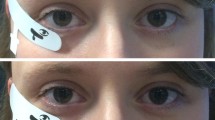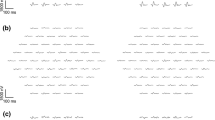Abstract
Purpose
Traditional ERGs recorded using corneal electrodes can be difficult for some patients to tolerate. In the last several years, adhesive skin electrodes have gained in acceptance. In this report we present a qualitative comparison of waveforms as well as a quantitative analysis of correlation of amplitudes and implicit times of simultaneous ERG recordings using contact lens and skin electrodes.
Methods
89 subjects were included; all were referred for full-field ERG testing for multiple indications. ERGs (obtained according to ISCEV standards) were recorded simultaneously from both eyes with ERG-jet corneal contact lens electrodes and LKC Technologies Sensor Strip adhesive skin electrodes using multi-channel instrumentation (Diagnosys LLC, Espion3). Waveforms, a-wave and b-wave amplitudes and implicit times were compared.
Results
Waveform morphologies were similar between electrode types. Regression coefficients (conversion factors) for a-wave and b-wave amplitudes under both photopic and scotopic conditions were tightly clustered. Regression coefficients for implicit times were nearly equal to 1.0. The regression coefficient for the entire amplitude dataset was 0.349, with an overall correlation of 0. 869 between amplitude recorded with skin and contact lens electrodes. The regression coefficient for the entire implicit time dataset was 0.967, with an overall correlation of 0.964 between skin and contact lens electrodes.
Conclusions
Our best estimate for the conversion factor between ERG amplitudes recorded with adhesive skin electrodes and contact lens electrodes is 0.349—amplitudes with skin electrodes are about 1/3 the amplitudes recorded simultaneously from the same eyes with contact lens electrodes, with a high correlation. Implicit times are nearly identical for the two electrode types.








Similar content being viewed by others
References
Wang D, Nair, A, Goldberg N, Friedman A, Jabs D, Brodie S (2020) Oscillatory potentials in patients with birdshot chorioretinopathy. Doc Ophthalmol 141. https://doi.org/10.1007/s10633-020-09776-x
McCulloch DL, Marmor MF, Brigell MG et al (2015) ISCEV Standard for full-field clinical electroretinography (2015 update). Doc Ophthalmol 130(1):1–12. https://doi.org/10.1007/s10633-014-9473-7
Kriss A (1994) Skin ERGs: their effectiveness in paediatric visual assessment, confounding factors, and comparison with ERGs recorded using various types of corneal electrode. Int J Psychophysiol 16(2):137–146
Lapkovska A, Palmowski-Wolfe AM, Todorova MG (2016) Comparing DTL microfiber and neuroline skin electrode in the mini ganzfeld ERG. BMC Ophthalmol 16:137. https://doi.org/10.1186/s12886-016-0311-4
Meredith SP, Reddy MA, Allen LE, Moore AT, Bradshaw K (2004) Full-field ERG responses recorded with skin electrodes in paediatric patients with retinal dystrophy. Doc Ophthalmol Adv Ophthalmol 109(1):57–66. https://doi.org/10.1007/s10633-004-1752-2
Osigian CJ, Grace SF, Cavuoto KM et al (2019) Assessing nonsedated handheld cone flicker electroretingram as a screening test in pediatric patients: comparison to sedated conventional cone flicker electroretinogram. J Am Assoc Pediatr Ophthalmol Strabismus 23(1):34.e1-34.e5. https://doi.org/10.1016/j.jaapos.2018.09.009
Yamashita T, Miki A, Tabuchi A, Funada H, Kondo M (2017) A novel method to reduce noise in electroretinography using skin electrodes: a study of noise level, inter-session variability, and reproducibility. Int Ophthalmol 37(2):317–324. https://doi.org/10.1007/s10792-016-0240-5
Bradshaw K, Hansen R, Fulton A (2004) Comparison of ERGs recorded with skin and corneal-contact electrodes in normal children and adults. Doc Ophthalmol Adv Ophthalmol 109(1):43–55. https://doi.org/10.1007/s10633-004-1751-3
Bui Quoc E, Albuisson E, Ingster-Moati I (2012) Accuracy and results of photopic flash electroretinogram performed with skin electrodes in infants. Eur J Ophthalmol 22(3):441–449. https://doi.org/10.5301/ejo.5000021
Fernandes AG, Salomão SR, Pereira JM, Berezovsky A (2016) Full-field electroretinogram recorded with skin electrodes in normal adults. Arq Bras Oftalmol 79(6):390–394. https://doi.org/10.5935/0004-2749.20160110
Hobby AE, Kozareva D, Yonova-Doing E et al (2018) Effect of varying skin surface electrode position on electroretinogram responses recorded using a handheld stimulating and recording system. Doc Ophthalmol Adv Ophthalmol 137(2):79–86. https://doi.org/10.1007/s10633-018-9652-z
Funding
Research to Prevent Blindness Grant. The LKC Sensor Strip adhesive electrodes for this study were provided by LKC Technologies, Gaithersburg, MD.
Author information
Authors and Affiliations
Corresponding author
Ethics declarations
Conflict of interest
All authors certify that they have no affiliations with or involvement in any organization or entity with any financial interest (such as honoraria; educational grants; participation in speakers’ bureaus; membership, employment, consultancies, stock ownership, or other equity interest; and expert testimony or patent-licensing arrangements) or non-financial interest (such as personal or professional relationships, affiliations, knowledge or beliefs) in the subject matter or materials discussed in this manuscript.
Compliance with Ethical Standards
All procedures performed in this study involving human participants were approved by and in accordance with the ethical standards of the New York University Langone Health Institutional Review Board (NYU IRB) and with the 1964 Helsinki declaration and its later amendments or comparable ethical standards. Written informed consent was obtained from all participants or their parents prior to examination.
Ethical Approval
All procedures performed in this study were approved the New York University Langone Health Institutional Review Board (NYU IRB).
Statement of human rights
All procedures performed in studies involving human participants were in accordance with the ethical standards of NYU Langone Health and with the 1964 Helsinki declaration and its later amendments or comparable ethical standards.
Statement on the welfare of animals
Not applicable.
Informed consent
For participation in this study was obtained in writing from all adult participants and/or from their parent or legal guardian (for participants who were minors), as specified by the NYU IRB.
Additional information
Publisher's Note
Springer Nature remains neutral with regard to jurisdictional claims in published maps and institutional affiliations.
Rights and permissions
About this article
Cite this article
Chen, D., Greenstein, V.C. & Brodie, S.E. Qualitative and quantitative comparison of ERGs with contact lens and adhesive skin electrodes. Doc Ophthalmol 144, 203–215 (2022). https://doi.org/10.1007/s10633-022-09868-w
Received:
Accepted:
Published:
Issue Date:
DOI: https://doi.org/10.1007/s10633-022-09868-w




